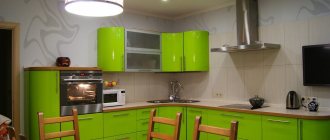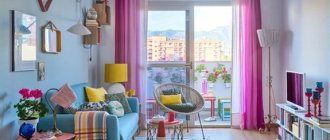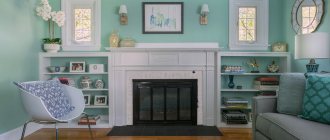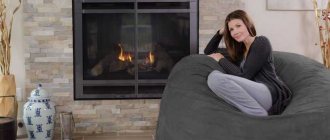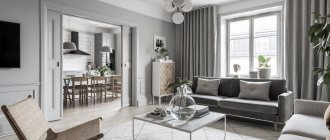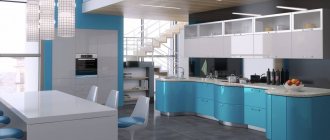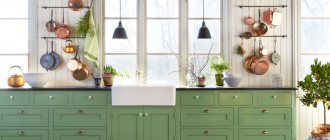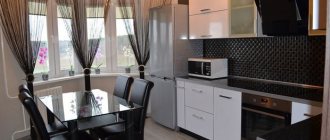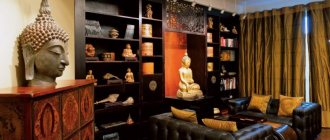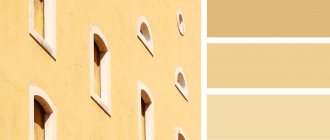Scandinavian style in the interior – one of the simplest and most laconic styles. It is natural and very natural. This stylistic direction came to us from Finland, Norway and other cold Scandinavian countries. But most of all, Scandinavian-style design expresses the simplicity and comfort of a Swedish home. After all, Sweden became the birthplace of this stylistic trend.
Until the 18th century, Scandinavian interiors and houses were built according to the principles of French Rococo and English classicism, fashionable at that time. During the reign of the Swedish king Gustav III, the European Empire style came into fashion, which in Sweden took on a slightly simplified form, and then spread throughout Scandinavia. The so-called " Gustavian style " was popular in those regions until the early 20th century. It is considered the predecessor of the modern Scandinavian style, which received a second “birth” in the middle of the last century.
White
White goes first and wins. So in the Scandinavian interior, white is the winner, the favorite, the king. They paint the walls and floors, buy white furniture and textiles, and choose white accessories. And this is not surprising, because there is so little sunshine in the Scandinavian countries. So the residents compensate for the lack with light shades.
Use white to decorate walls, ceilings, and plank floors. Light wooden furniture or a sofa with lots of decorative pillows is also appropriate.
NCS colors
ColorScheme
· Tool for selecting colors and generating color schemes ·
Color Wheel Online ⇒
Site MapColor NamesCar ColorsColor Names in HTMLColor Converter
The NCS (Natural Color System) color system is a proprietary color model proposed by the Swedish Color Institute. It is based on a system of opposing colors and has found widespread use in industry to describe the color of products. Today, NCS is one of the most widely used color description systems in the world, has received international scientific recognition, and is also the national standard in Sweden, Norway, Spain, and South Africa.
The system is typically used for describing and matching colors rather than mixing colors. NCS is the only system that describes color as we see it, making it clear, logical and easy to use. Within the NCS system, it is possible to identify any of the millions of shades and give it an exact designation.
When describing color, the NCS uses six elementary colors, colors that cannot be described by a combination of two others (for example, elemental red is only red, without yellow or blue shades). Of these, four chromatic colors are Yellow (Y), Red (R), Blue (B) and Green (G), and two non-chromatic colors – White (W) and Black (Swarthy, S) ). The remaining colors are represented by a combination of elementary ones (for example, orange is both reddish and yellowish). This similarity is called the elementary characteristics of color (yellowness, redness, whiteness, etc.).
- Color:
- Page 1
- <
- >
| Sample | NCS color | C | M | Y | K | HTML | R | G | B |
| NCS S 0300-N | 0 | 0 | 0 | 0 | #FFFFFF | 255 | 255 | 255 | |
| NCS S 0500-N | 0 | 0 | 1 | 1 | #FCFCFB | 252 | 252 | 251 | |
| NCS S 1000-N | 0 | 0 | 2 | 6 | #F2F2F0 | 242 | 242 | 240 | |
| NCS S 1500-N | 0 | 1 | 2 | 14 | #E0DFDE | 224 | 223 | 222 | |
| NCS S 2000-N | 0 | 1 | 2 | 18 | #D8D8D7 | 216 | 216 | 215 | |
| NCS S 2500-N | 0 | 1 | 2 | 23 | #CECDCC | 206 | 205 | 204 | |
| NCS S 3000-N | 0 | 1 | 3 | 29 | #C0BFBE | 192 | 191 | 190 | |
| NCS S 3500-N | 0 | 1 | 3 | 36 | #B0B0AF | 176 | 176 | 175 | |
| NCS S 4000-N | 0 | 1 | 3 | 41 | #A5A5A4 | 165 | 165 | 164 | |
| NCS S 4500-N | 0 | 1 | 4 | 47 | #979796 | 151 | 151 | 150 | |
| NCS S 5000-N | 0 | 1 | 4 | 51 | #8E8E8D | 142 | 142 | 141 | |
| NCS S 5500-N | 0 | 2 | 5 | 55 | #858583 | 133 | 133 | 131 | |
| NCS S 6000-N | 0 | 2 | 5 | 60 | #7A7977 | 122 | 121 | 119 | |
| NCS S 6500-N | 0 | 2 | 5 | 65 | #6D6D6B | 109 | 109 | 107 | |
| NCS S 7000-N | 0 | 2 | 5 | 70 | #60605E | 96 | 96 | 94 | |
| NCS S 7500-N | 0 | 2 | 5 | 75 | #545452 | 84 | 84 | 82 | |
| NCS S 8000-N | 0 | 2 | 5 | 82 | #434241 | 67 | 66 | 65 | |
| NCS S 8500-N | 10 | 0 | 15 | 92 | #262824 | 38 | 40 | 36 | |
| NCS S 9000-N | 15 | 0 | 25 | 100 | #111410 | 17 | 20 | 16 | |
| NCS S 0502-Y | 0 | 0 | 8 | 0 | #FFFDF2 | 255 | 253 | 242 | |
| NCS S 1002-Y | 0 | 0 | 10 | 10 | #EAE8DB | 234 | 232 | 219 | |
| NCS S 1502-Y | 0 | 0 | 10 | 20 | #D5D3C7 | 213 | 211 | 199 | |
| NCS S 2002-Y | 0 | 0 | 10 | 25 | #C9C8BD | 201 | 200 | 189 | |
| NCS S 2502-Y | 0 | 0 | 10 | 33 | #B8B7AD | 184 | 183 | 173 | |
| NCS S 3502-Y | 0 | 0 | 11 | 46 | #9A9B92 | 154 | 155 | 146 | |
| NCS S 4502-Y | 0 | 0 | 12 | 55 | #86867E | 134 | 134 | 126 | |
| NCS S 5502-Y | 0 | 0 | 12 | 65 | #6D6D66 | 109 | 109 | 102 | |
| NCS S 6502-Y | 0 | 0 | 12 | 75 | #55554F | 85 | 85 | 79 | |
| NCS S 7502-Y | 0 | 0 | 12 | 88 | #353430 | 53 | 52 | 48 | |
| NCS S 8502-Y | 0 | 0 | 15 | 100 | #151311 | 21 | 19 | 17 | |
| NCS S 0502-Y50R | 0 | 2 | 10 | 0 | #FFFAED | 255 | 250 | 237 | |
| NCS S 1002-Y50R | 0 | 3 | 10 | 7 | #F0E9DD | 240 | 233 | 221 | |
| NCS S 1502-Y50R | 0 | 4 | 10 | 17 | #DAD4CA | 218 | 212 | 202 | |
| NCS S 2002-Y50R | 0 | 5 | 10 | 25 | #C8C1B9 | 200 | 193 | 185 | |
| NCS S 0502-R | 0 | 2 | 3 | 0 | #FFFBF8 | 255 | 251 | 248 | |
| NCS S 1002-R | 0 | 3 | 5 | 10 | #E9E4DF | 233 | 228 | 223 | |
| NCS S 1502-R | 0 | 4 | 5 | 20 | #D4CFCC | 212 | 207 | 204 | |
| NCS S 2002-R | 0 | 5 | 5 | 27 | #C3BEBC | 195 | 190 | 188 | |
| NCS S 2502-R | 0 | 5 | 5 | 32 | #B9B4B2 | 185 | 180 | 178 | |
| NCS S 3502-R | 0 | 5 | 5 | 50 | #918D8D | 145 | 141 | 141 | |
| NCS S 4502-R | 0 | 5 | 5 | 60 | #7A7776 | 122 | 119 | 118 | |
| NCS S 5502-R | 0 | 6 | 10 | 65 | #6C6965 | 108 | 105 | 101 | |
| NCS S 6502-R | 0 | 8 | 10 | 75 | #54504D | 84 | 80 | 77 | |
| NCS S 7502-R | 0 | 9 | 10 | 90 | #2F2C2A | 47 | 44 | 42 | |
| NCS S 8502-R | 0 | 10 | 10 | 100 | #161212 | 22 | 18 | 18 | |
| NCS S 0502-R50B | 2 | 2 | 0 | 0 | #FCFBFD | 252 | 251 | 253 | |
| NCS S 1002-R50B | 2 | 2 | 0 | 12 | #E1E2E5 | 225 | 226 | 229 | |
| NCS S 1502-R50B | 4 | 4 | 0 | 18 | #D1D1D6 | 209 | 209 | 214 | |
| NCS S 2002-R50B | 4 | 4 | 0 | 28 | #BCBDC2 | 188 | 189 | 194 | |
| NCS S 0502-B | 3 | 0 | 0 | 0 | #FAFDFF | 250 | 253 | 255 | |
| NCS S 1002-B | 4 | 0 | 0 | 10 | #E3E8EA | 227 | 232 | 234 | |
| NCS S 1502-B | 4 | 0 | 0 | 18 | #D2D7DA | 210 | 215 | 218 | |
| NCS S 2002-B | 4 | 0 | 0 | 27 | #BFC4C7 | 191 | 196 | 199 | |
| NCS S 2502-B | 4 | 0 | 0 | 35 | #AEB3B6 | 174 | 179 | 182 | |
| NCS S 3502-B | 4 | 0 | 0 | 50 | #8D9194 | 141 | 145 | 148 | |
| NCS S 4502-B | 4 | 0 | 0 | 60 | #767A7C | 118 | 122 | 124 | |
| NCS S 5502-B | 7 | 0 | 0 | 70 | #5B5F61 | 91 | 95 | 97 | |
| NCS S 6502-B | 9 | 0 | 0 | 80 | #434749 | 67 | 71 | 73 | |
| NCS S 7502-B | 12 | 0 | 0 | 90 | #292D2F | 41 | 45 | 47 | |
| NCS S 8502-B | 30 | 0 | 0 | 100 | #091115 | 9 | 17 | 21 | |
| NCS S 0502-B50G | 3 | 0 | 4 | 0 | #FAFDF8 | 250 | 253 | 248 | |
| NCS S 1002-B50G | 4 | 0 | 5 | 8 | #E7EBE6 | 231 | 235 | 230 | |
| NCS S 1502-B50G | 7 | 0 | 5 | 19 | #CBD3D0 | 203 | 211 | 208 | |
| NCS S 2002-B50G | 8 | 0 | 5 | 28 | #B6BFBD | 182 | 191 | 189 | |
| NCS S 0502-G | 3 | 0 | 5 | 0 | #FAFDF7 | 250 | 253 | 247 | |
| NCS S 1002-G | 5 | 0 | 8 | 5 | #EBF0E7 | 235 | 240 | 231 | |
| NCS S 1502-G | 5 | 0 | 8 | 15 | #D6DBD3 | 214 | 219 | 211 | |
| NCS S 2002-G | 5 | 0 | 8 | 25 | #C1C6BF | 193 | 198 | 191 | |
| NCS S 2502-G | 5 | 0 | 8 | 33 | #B0B5B0 | 176 | 181 | 176 | |
| NCS S 3502-G | 5 | 0 | 8 | 47 | #919692 | 145 | 150 | 146 | |
| NCS S 4502-G | 5 | 0 | 8 | 55 | #808481 | 128 | 132 | 129 | |
| NCS S 5502-G | 5 | 0 | 8 | 70 | #5C5F5C | 92 | 95 | 92 | |
| NCS S 6502-G | 5 | 0 | 8 | 80 | #464845 | 70 | 72 | 69 | |
| NCS S 7502-G | 10 | 0 | 8 | 90 | #2B2E2C | 43 | 46 | 44 | |
| NCS S 8502-G | 10 | 0 | 20 | 100 | #131411 | 19 | 20 | 17 | |
| NCS S 0502-G50Y | 2 | 0 | 5 | 0 | #FCFDF7 | 252 | 253 | 247 | |
| NCS S 1002-G50Y | 2 | 0 | 5 | 5 | #F0F2EB | 240 | 242 | 235 | |
| NCS S 1502-G50Y | 3 | 0 | 10 | 15 | #DADCD0 | 218 | 220 | 208 | |
| NCS S 2002-G50Y | 3 | 0 | 10 | 25 | #C4C7BD | 196 | 199 | 189 | |
| NCS S 0505-Y | 0 | 0 | 14 | 0 | #FFFBE7 | 255 | 251 | 231 | |
| NCS S 0507-Y | 0 | 0 | 25 | 0 | #FFF9D6 | 255 | 249 | 214 | |
| NCS S 0510-Y | 0 | 0 | 30 | 0 | #FFF8CA | 255 | 248 | 202 | |
| NCS S 0515-Y | 0 | 0 | 35 | 0 | #FFF6BE | 255 | 246 | 190 | |
| NCS S 0520-Y | 0 | 3 | 46 | 0 | #FFEEA7 | 255 | 238 | 167 | |
| NCS S 0530-Y | 0 | 3 | 55 | 0 | #FFEB92 | 255 | 235 | 146 | |
| NCS S 0540-Y | 0 | 3 | 70 | 0 | #FEE66B | 254 | 230 | 107 | |
| NCS S 0550-Y | 0 | 7 | 80 | 0 | #FDDD4E | 253 | 221 | 78 | |
| NCS S 0560-Y | 0 | 10 | 90 | 0 | #FDD72C | 253 | 215 | 44 | |
| NCS S 0570-Y | 0 | 8 | 100 | 0 | #FAD500 | 250 | 213 | 0 | |
| NCS S 0580-Y | 0 | 12 | 100 | 0 | #F9CF00 | 249 | 207 | 0 | |
| NCS S 1005-Y | 0 | 0 | 20 | 5 | #F5F0D3 | 245 | 240 | 211 | |
| NCS S 1010-Y | 0 | 1 | 35 | 5 | #F4EAB5 | 244 | 234 | 181 | |
| NCS S 1015-Y | 0 | 3 | 38 | 4 | #F6E9B0 | 246 | 233 | 176 | |
| NCS S 1020-Y | 0 | 4 | 43 | 5 | #F4E5A3 | 244 | 229 | 163 | |
| NCS S 1030-Y | 0 | 8 | 55 | 3 | #F6DE8A | 246 | 222 | 138 | |
| NCS S 1040-Y | 0 | 10 | 60 | 2 | #F9DD80 | 249 | 221 | 128 | |
| NCS S 1050-Y | 0 | 12 | 80 | 0 | #FED74C | 254 | 215 | 76 | |
| NCS S 1060-Y | 0 | 13 | 90 | 0 | #FCD32B | 252 | 211 | 43 | |
| NCS S 1070-Y | 0 | 17 | 90 | 2 | #F7CA27 | 247 | 202 | 39 | |
| NCS S 1080-Y | 0 | 20 | 100 | 5 | #ECBC00 | 236 | 188 | 0 |
- Color:
- Page 1
- <
- >
Grey
The style involves the use of all shades of white and gray is such. Usually it is used to paint one of the walls in the room, and also buy gray furniture and some decorative elements. This color acts as a contrast when you need to visually highlight a certain area or highlight some accessories.
Sometimes gray can act as the main color, but in this case it is better to use it in spacious rooms.
Black
The color scheme of the Scandinavian style allows for this strict and deep color. There is very little of it, black is applied in doses. For example, it could be black and white tiles on the floor, a black slate board in a children's room or kitchen, wooden chairs mixed with brown or white, lamps coated with black glossy paint.
Ivory
This is an alternative to a snow-white shade. The ivory version looks good in a bedroom or children's room. It goes well with others, for example, with the color of wet asphalt, pink, blue, light green. You can create a design for one room that will be entirely based on shades of a given color. It looks quite stylish and organic.
Floors and walls
A distinctive feature of the Scandinavian interior style are the walls. They are covered with perfectly white or beige plaster, light gray or light blue paint. Alternatively, you can decorate them with wooden panels - this will make the room more comfortable and cozy. Parquet or laminate are perfect for the floor: wooden floors in bright colors are very common in Scandinavian interiors.
A fluffy carpet or a regular patchwork runner will, of course, enliven the atmosphere and make it more comfortable and homely. White or pale blue tiles will look good in the bathroom.
Scandinavian style in walnut color
Essentially, the color “walnut” is a rich light or dark brown. It is quite natural for Scandinavian design. Natural wood is used everywhere here: in furniture, decorative elements, and flooring. Walnut color can also be used in an alternative to parquet such as laminate. At the same time, do not forget that 2/3 of the overall furnishings should consist of natural materials.
Color solutions for interiors in Scandinavian style
Encyclopedia mapThe main role in the Scandinavian interior is given to the color scheme, which here is not very diverse. She is quite reserved, white is always dominant. An additional palette is taken from nature: the northern sea, sky, wood, stone, earth and sand. Milky, ivory, eggshell - they all have a place in Scandi color schemes.
To fill the space with freshness and natural color, Scandinavian-style interiors use splashes of color that fill them with special energy.
Scandinavian style is a style close to nature, which allows a variety of shades in its interior. The landscapes of Norway, Denmark, Sweden are snow-capped hills, fog, frost on tree branches, bottomless blue lakes, deep green forests and golden sunsets.
In general, the Scandinavian style is characterized by light, slightly cool tones, but it is important not to overdo it with coldness and choose the perfect shade. Choose the main background, based on which side - north or south - the windows face. Avoid a gray palette if the direction is north.
Modern fashion dictates the rules in color style, trendy shades and their combinations. The white-gray or even white-black, or even all-white Scandinavian interior that we are used to is no longer the ultimate truth. Designers recommend choosing today's fashionable powder pink, yellow, blue, dark green and shades of turquoise. Although the classics remain out of fashion.
White
Scandinavian interior in white is a classic that has not lost its relevance. White is the constant background of the Scandi style. Wall decoration, ceiling color or furniture set are most often white. Surfaces can have different textures - from smooth glossy to matte. The inclusions can be very different - white contrasts perfectly with blue, blue, and gray shades. Details are also important: soft wood as a finishing material, ideal light, straightforwardness in interior design, as well as contrasting color inserts that will highlight the white tone.
When it comes to the kitchen, an apron with an intense print can add depth. The following range is suitable: ash, wet asphalt, red, blue and its varieties.
A white Scandinavian-style bedroom is a timeless classic. White goes well with other shades. White color as a background is very convenient. You can change the decor at any time and the interior will be transformed. White Scandinavian bedrooms can be found in small apartments or in rooms with low lighting. This makes the room visually expand and look brighter.
Pastel shades
The colors of the northern lights will look appropriate as decorative elements. They are often used for lighting - tints from pinkish-violet to sunny colors can be better effectively reproduced using colored light bulbs and LED strips.
Studio head advice
Create the interior of your dreams with the designers of our studio
Each of our projects reflects the needs, taste and lifestyle of our client
Calculate the cost
Grey
The harsh climate of the northern countries can be emphasized with an interior in a predominantly gray shade. Gray color is quite versatile and goes well with other classic shades. The gray color in a Scandinavian style interior very accurately conveys the color and Nordic mood: clouds hanging over the city, foggy streams, rocky mountains and stones, dark streams and unexplored roads.
You can combine gray color both in decoration and in decorative elements or furniture. The texture to choose from is transparent-smooth or rough surfaces, metal elements or fluffy rugs and chair covers.
If gray is chosen as the main color, stop at its light version. Whitewashed gray goes well with wood floors and white furniture. The white door and ceiling will also harmonize with the light gray interior. You can use gray to decorate only one wall - it is stylish and visually expands the space. You can decorate the walls so that the bottom is gray and the top is white. This way, you will raise the ceiling height and ensure practicality. The lower part of the wall, made in gray, will help avoid dirt and dust. The gray and white furnishings need to be diluted. Bright details in a Scandinavian interior can include a patterned rug with an ornament, original posters in multi-colored frames, or vases with living plants.
Beige
The beige color has many varieties and can also be used in Scandinavian interiors. The color of baked milk is a good option for decorating walls, ceilings, and flooring.
This choice of color will emphasize the sophistication of the Scandinavian style. Very beautiful beige tones harmonize with peach, coffee and light green shades.
Blue
Deep blue color as a symbol of the pure tones of water or the evening sky is also appropriate in a Scandi interior. This shade contrasts very favorably with the main tones in the design, such as white, wood or light gray. Blue can be used in wall decoration and as the main color of furniture. In this case, it is better to choose smooth surfaces.
Green
Green is the color of life and peace. This is the embodiment of coniferous forest and water depth. Green can become an ally if you correctly combine it with white, black or gray shades. In addition, the interior must have a place for living plants, indoor flowers and greenery in pots.
You need to be careful with dark green - it’s easy to make the room too dark and boring. To prevent this from happening, choose several shades of dark green, combine it with mustard, dilute it with white, gray or light brown.
Planning in an hour! Order a designer consultation and development of an individual layout for only 3,000 rubles.
Make an order
Olive
Comfort and coziness are one of the main indicators of the Scandinavian style. Calm and laconic olive will help achieve this. Walls decorated with olive wallpaper and white wood furniture will look harmonious - stylish, cozy and very warm. A more saturated olive color can be used in individual decorative elements.
Yellow
Yellow shades in the Scandinavian style make up for the lack of sun in the northern countries. A cozy soft yellow chair, yellow pillows contrasting with a gray sofa or ceramic splashes as a bright accent, abstract paintings, colored candles or carpets of different sizes - bright yellow details are successfully combined with fairly restrained white-gray walls and a wooden floor.
Powdery pink
Its shades are soft, gentle, calming. Designers recommend using shades of powdery pink in spacious and bright rooms with large windows. The shades appear best in the sun.
Choose individual interior details in this color: curtains, pillows, you can paint one wall powdery pink. This color goes well with delicate shades of beige. The color scheme in a Scandinavian interior allows you to experiment with pastel colors.
Powder pink is a versatile color that can be used in the bedroom and living room, kitchen and even bathroom.
However, it is important to choose the right shade. For Scandi style, choose creamy peach - combining it with gold, you will get a very cozy and warm space, and with olive - strict and elegant.
Black
A contrasting combination of colors, such as black and white, in combination with natural wood furniture is a very stylish and suitable option, for example, for a hallway. It is important not to overdo it with black; it should be organically present in the space and not overload the appearance of the room. Usually black color is introduced as elements: floor mat, hangers, coat hooks, photo frames, vases. There are also examples where black fits more boldly into the Scandinavian space. Decorate the floor with black, the walls with light gray, the ceiling and furniture with white - this solution is often used in modern Scandinavian hallways.
Scandinavian style is restrained, strict, but cozy, imbued with lightness, cleanliness and light.
Bright spots in a Scandinavian interior
The color palette of the Scandinavian style is not limited to pastel shades, but also allows for the use of bright colors. There just aren’t many of them in the design and they should be as close to natural as possible. For example, a shade of a bright azure sea, poppy petals, sun, green meadow, wildflowers, violets, a shade of summer, if you want. Decorative elements become bright spots in the interior:
- Textile decorative pillows.
- Blankets and bedspreads with geometric patterns.
- Multi-colored pots for plants.
- Abstract paintings.
- Designer upholstered furniture.
- Colored candles.
- Carpets and runners.
- Bright frames for black and white photographs (playing on contrast).
Features of Scandinavian interior
Scandinavian style is ideal for bringing tranquility to the home. Its modern designs, luminous tones and pleasing textures are the key to creating extremely cozy interiors that compensate for the cold northern climate.
Most Scandinavian-style sofas are upholstered in fabrics in a variety of shades, from light gray and anthracite to darker colors such as pink, yellow or green and even patterned fabric.
In Scandinavian style - the main character. Light wood is also an irreplaceable material. We can also add quartz pink tones for a more romantic bedroom and blue touches for the living room. If you're a little bolder, you can add some of the trendiest materials, such as copper. And we always finish decorating the space with a plant that brings nature closer to our home.
How to correctly combine colors in the interior
To create a harmonious hygge interior, it is important not only to know about its basic colors and general principles of organization, but also to adhere to some color rules:
- Use black in doses, dilute it with shades of green, red, blue.
- Red is acceptable in Scandinavian design, but choose muted and deep shades.
- Use light shades of purple in textiles and upholstery. Lilac and lavender are suitable for creating an interior in the style of Scandinavian Provence.
- Green is your ally in everything: it can easily be combined with gray, yellow, black, white and it will definitely be present in a Scandinavian interior, at least in the form of green living plants.
- Choose a classic Scandi style palette for your children's room: white, beige, light gray, blue, powder pink.
- For the kitchen, you can choose several colors, for example, white and lemon, gray and white, gray and light green.
- In a bright living room, bright accents in the form of decor and some types of furniture would be appropriate.
- For the bedroom, choose neutral base shades.
- For the bathroom and toilet, choose basic white and play with the floor and walls. Colored ceramic tiles can add playfulness to your space.
In Scandinavian design, the color range is actually not limited by any boundaries. This trend simply has certain rules of organization: minimalism, use of natural materials, lots of light, space. Therefore, it won’t be possible to go wild in terms of using bright colors.
Rules for combining colors
To create a stylish and harmonious interior, you need to know the basic principles of working with shades :
- Bright colors must be muted. Flashy shades do not at all correspond to Scandinavian design.
- Green is an ally in everything. It is not only the most essential color, but also a great companion for other shades (such as white, yellow, gray or black).
- For the bedroom, it is best to use a neutral base palette.
- White is the main color for finishing the kitchen, bright living room, bathroom and toilet.
Scandinavian style is not limited to just the basic palette. To design a stylish interior, various shades are used that must be combined correctly. By adhering to the basic principles and recommendations of experts, everyone will have the opportunity to create a Scandinavian design for their home.
You will learn about interior design options in Scandinavian style from the following video :


